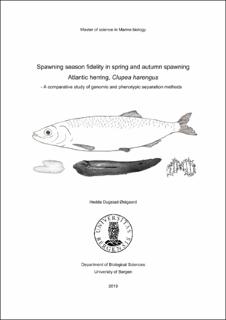| dc.description.abstract | Atlantic herring have a complex population structure and show a wide range of life history strategies, including spawning times and locations. Time of spawning is a key characteristic for population separation. Spawning timing fidelity is often assumed in herring, that is they spawn in the same season as they hatched. However, low rates of spawning season switching (straying), is observed in a number of stocks suggesting interbreeding between populations. Spring and autumn are the most common spawning seasons among Northeast Atlantic herring populations. Seasonally spawning herring are traditionally separated on their gonadal maturity stage at sampling, but otolith microstructure has also been used to separate herring form mixed catches. Genetic discreteness was recently documented for spring and autumn spawning herring. The present thesis investigates population structure and dynamics between spring and autumn spawning herring. Phenotypic maturity status was related to two genomic SNPs markers. In addition, hatching season was determined through visual reading of otolith microstructures, corroborating the already known spawning season pattern. Herring were sampled during spring and autumn at the same locations in western Norway from autumn 2016-2018. Spawning herring (ripe and running) were found in both sampling seasons but spring spawning herring dominated in all samples. Herring were successfully separated to spawning type spring or autumn by the three separation methods. Correspondence was generally high, but some spawning season switching was also observed. In autumn samples, straying was documented among the autumn spawning herring (45.0%), while the spring sampled spring spawning herring showed high fidelity (95.2%). These results suggest an increased effect of straying on the less abundant autumn spawning herring. When comparing separation methods two by two the correspondence was highest between hatching season and genetic spawning season. It is suggested that adaption to spawn in spring or autumn causes selective pressures which keeps isolation between seasonal spawning populations. When comparing all separation methods, the correspondence was highest for the SNPs test. SNPs markers have great potential for separating spring and autumn spawning herring from mixed catches and should be implemented as a separation method in assessment of mixed herring stocks. | |
